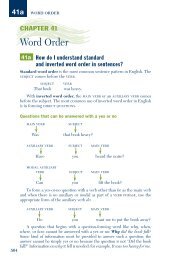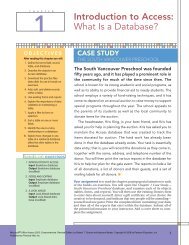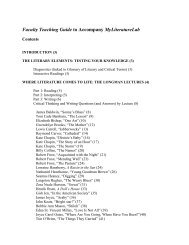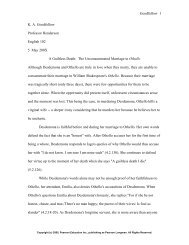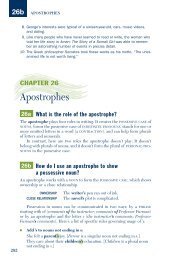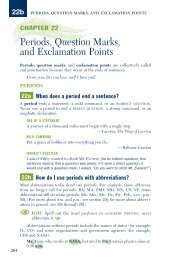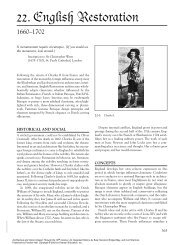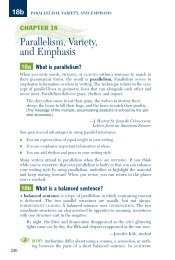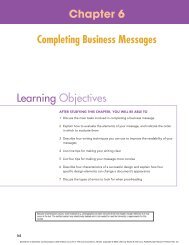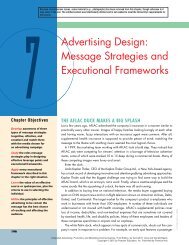chapter 3 - Pearson Learning Solutions
chapter 3 - Pearson Learning Solutions
chapter 3 - Pearson Learning Solutions
You also want an ePaper? Increase the reach of your titles
YUMPU automatically turns print PDFs into web optimized ePapers that Google loves.
2009934667<br />
The proponents of NLP (Neurolingistic Programming) believe that eye movements are linked to<br />
the sensory processing that goes on in a person's mind when he or she is thinking. The eye<br />
movement may be a flicker or it may be held for several seconds. This movement happens when<br />
a person is organizing incoming sensations, recalling past experiences, or imagining never<br />
previously experienced phenomena.<br />
Eyes up and to the left:<br />
Recalling something seen<br />
before—a visual memory.<br />
Eyes up and to the right:<br />
Visualizing something that<br />
has not been seen before.<br />
Chapter 3 Nonverbal Communication 59<br />
That we are born with some of our nonverbal tendencies is illustrated by the<br />
fact that “people born blind move their hands when they talk, although they’ve<br />
never seen anyone do it.” 10<br />
A study of eye-accessing cues indicates “whether a person is thinking in<br />
images, sounds, self-talk, or through their feelings their eyes move in patterns.” 11<br />
Most people, according to neurolinguistic psychological (NLP) research, will<br />
look up for visual accessing, down for linguistic accessing, to the left for past<br />
experiences, to the right for future perceptions, and straight ahead for the presenttense<br />
thinking. 12 “Some NLP experts consider eye movements to be an aid to<br />
accessing inner speech since the eye movements stimulate different parts of the<br />
brain.” 13 If this is true, then following the advice that one should maintain good<br />
eye contact when speaking to someone would render “a person unable to make<br />
the accessing movements” 14 and could “interfere with and slow down the [person’s]<br />
normal thinking style.” 15 In academia, teachers often make the mistake of<br />
misinterpreting students’ actions. For example, a teacher asks a question, and<br />
you struggle to visualize the answer, your eyes moving up or down and to the<br />
left or right [depending on whether you are looking for past learned ideas or<br />
inventing new material]. The teacher states, “Well, you won’t find the answer on<br />
the ceiling.” The teacher is wrong. The answer may be found by glancing up and<br />
to the left if your normal eye-glance pattern for past tense and picturing concepts<br />
is up. 16 (See Figure 3.1.)<br />
A student who knows his or her eye-shift pattern may be able to access pasttense<br />
learning by moving his or her eyes in the direction of his or her past-tense<br />
Eyes centered, looking up:<br />
present tense visual memory;<br />
eyes centered, looking down:<br />
present tense verbal<br />
memory; eyes centered,<br />
staring (no matter whether<br />
eyes are up or down):<br />
daydreaming or not engaged<br />
in decoding any information<br />
being sent.<br />
FIGURE 3.1<br />
Eye-Accessing Cues<br />
Communicating: A Social and Career Focus, Tenth Edition, by Roy M. Berko, Andrew D. Wolvin, and Darlyn R. Wolvin. Published by Allyn & Bacon.<br />
Copyright © 2007 by <strong>Pearson</strong> Education, Inc.<br />
Source: “People Who Read<br />
People,” Psychology Today, July<br />
1979. Reprinted with permission<br />
from Psychology Today magazine,<br />
copyright © 1979 Sussex<br />
Publishers, Inc. For further<br />
information see The Pegsasus<br />
Mind-Body Newsletter, Issue 9,<br />
January 4, 2002, and research on<br />
neurolinguistic programming.




